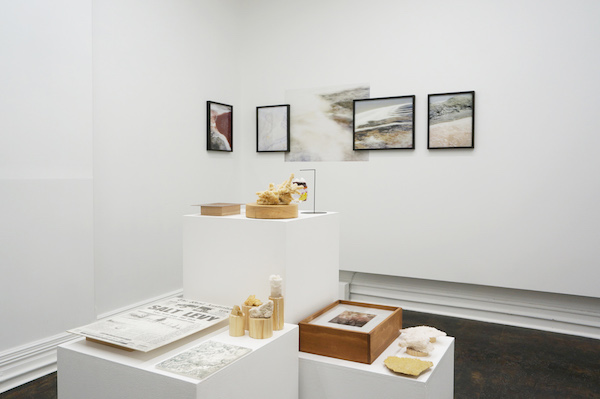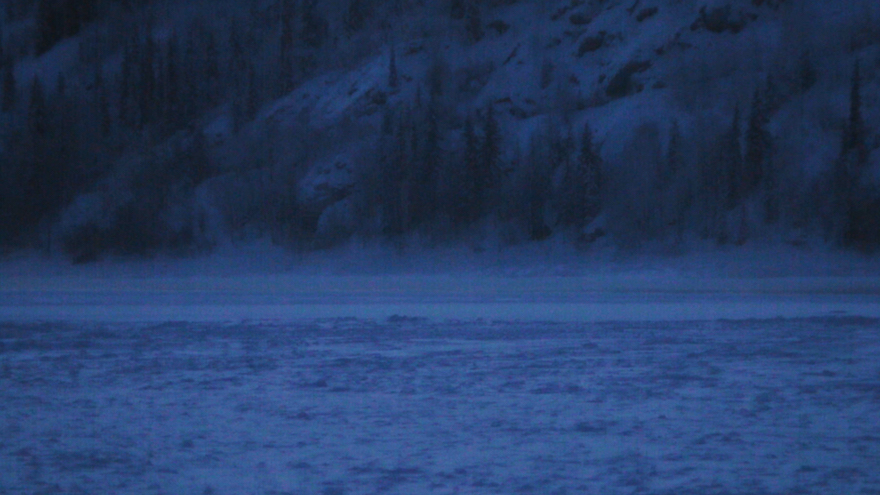Review: Rebecca McCauley & Aaron Claringbold, ‘Speaking to the Surface of Lake’; Matt Aitkin and Mei Swan Lim, ‘Land Sale’; Tessa Rex, ‘Sequestered’; James Doohan & Bianca Sharkey, ‘Astro Morphs Ascension’ ·
Cool Change Contemporary ·
Review by Belinda Hermawan ·
One of Perth’s newest artist-run initiatives, Cool Change Contemporary, has curated a joint exhibition that explores landscape, perspective and the ever-challenging impact of mankind on our natural environment. Located in separate gallery spaces, the artists’ works transcend the walls that divide them, drawing invisible lines of connection.
Matt Aitken and Mei Swan Lim’s “Land Sale”, showing in Gallery 2, is a mixed media delight that is the most successful of the four exhibitions. Their play on “yellow sand” and “white sand” highlights the incompatibility of urban sprawl and conservation efforts. The Home Reno Craft tables look like furniture you’d find in a kindergarten – chunky and childlike, a white and yellow puzzle suggestive of play. But this infantility hints at a collective ignorance, something that is highlighted and critiqued by the title AV installation, in which we watch land being cleared for housing developments and witness the pervading social emptiness of streets built on these fringes.
Aitken and Lim’s Mountain Dune features fluorescent yellow sand in a PVC bottle, suggesting an unnatural toxicity that is also alluded to in several of the photographs on the opposite wall, in contrast to the natural yellow of desert landscape. The lines linking evidentiary materials in the Big Map are also fluorescent yellow, rather than the red often used in depictions of investigation or conspiracy maps, and the tongue-in-cheek evidence causes its own alarm when you realise these “crimes” are not so funny after all.

There are some stunning shots of unceded land in Rebecca McCauley and Aaron Claringbold’s “Speaking to the Surface of a Lake” in Gallery 1. The artists have purposely dispensed with the trope of the horizontal line on which landscape photography has long relied, successfully frustrating the viewer, who can no longer judge scale. The photographs of Lake King are a highlight in this regard, also capturing hues and textures absent from the type of photography one might see in, say, tourism campaigns.
The various salt compositions on display are also unique, though their placement on the window sill and centre plinth seems to underplay how much of a natural wonder they are. Perhaps this is the point, to place the extraordinary in the ordinary, unsettling the viewer. There is also a lot of unused floorspace around the crowded centre plinth and, while this may be a deliberate play on our sense of scale, the obvious vastness acts to reduce the images; on first glance, one might dismiss the photographs as stock images.

The viewing of Tessa Rex’s “Sequestered” in Gallery 3 seems to suffer as a result of the way it has been installed. Rex’s title work is a nine-minute video loop, but it’s difficult to engage with the projected Arctic image and the classical audio track. There is nowhere to sit, and standing is a disorienting experience when you’re not sure if you’re meant to be looking for changing nuances in the image or whether it is permanently static (or, in fact, jammed). Similarly, it’s easy to dismiss the music as a dramatic device. On reading about Rex’s residency in sub-arctic Canada it becomes clear this former activist and now non-classical documentary maker has put a lot of thought into this piece, and it translates better when viewed online. The three “experiments”, backlit with pink light in the centre of the room, are diminished by the confusion over the video experience.

In the Project Space room, James Doohan and Bianca Sharkey’s Astro Morphs is a highly original, colourful performance piece that embraces human movement and playfully incorporates molecular patterns. It is deliberately cryptic, with the artists delivering a “nuanced confusion”, as they term it, in the journey of characters Yow and Sox. Again, the way the work has been installed in the space affected this viewing experience. While there is a bench to sit on, there isn’t a blackout curtain at the door (as there is in Gallery 3) and complete cinema blackout is, arguably, required to hold the viewer’s attention to the psychedelic visuals. The inclusion of three masks and a full-body suit – props from the performance – at the side of the room distracts the eye, and the open-door entrance is an exit reminder. This creative piece is likely best enjoyed while fully immersed.
This was my first visit to Cool Change, and its location on the first floor of the Bon Marche building is surprisingly secluded. I look forward to seeing what this ARI has in store for us next.
The exhibitions continue until 15 December.
Pictured top: James Doohan & Bianca Sharkey, ‘Ascension’ (from ‘Astro Morphs’), 2018, single channel video, 11:50.
Like what you're reading? Support Seesaw.





